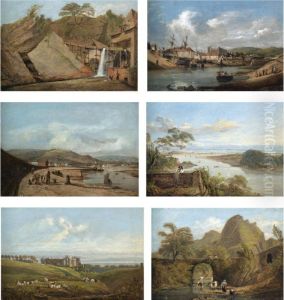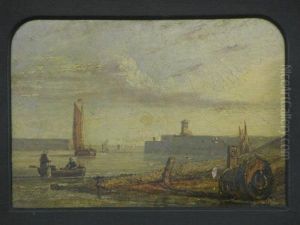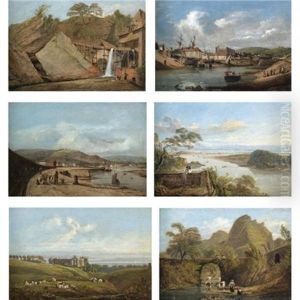George Orleans Delamotte Paintings
George Orleans Delamotte was a British artist known primarily for his works as a draughtsman and watercolorist. Born in 1771, Delamotte was part of the late 18th-century and early 19th-century art scene in Britain. Although not as widely recognized as some of his contemporaries, he contributed to the visual documentation of British landscape and architecture during a period that saw a growing interest in such themes, partly due to the rise of the Picturesque movement.
Delamotte came from a family of artists. His father, Philip Delamotte, was a French artist who had emigrated to Britain. George Orleans Delamotte often focused on landscapes and was known for his attention to detail and the atmospheric effects in his scenes. His works are characterized by delicate line work and a keen observation of his subjects, which ranged from rural landscapes to the grandeur of historical architectural edifices.
Throughout his career, Delamotte exhibited at prestigious institutions, including the Royal Academy of Arts. His works were appreciated by a clientele that sought to capture the beauty of the British countryside and its historic sites. Delamotte's artistic output was part of a larger trend in which art became increasingly accessible to the middle classes in Britain, a phenomenon that was aided by the production of prints and the growing practice of art collection among those outside the aristocracy.
George Orleans Delamotte was also an educator, and he had a significant impact on the development of art education in Britain. He was involved in the establishment of the Government School of Design, which later became the Royal College of Art. His influence extended to the training of young artists and the promotion of design in the industrial arts, which was a crucial aspect of Britain's burgeoning industrial economy.
Delamotte lived through a transformative period in British history, witnessing the effects of the Industrial Revolution, the expansion of the British Empire, and significant social changes. He died in 1863, having seen the Victorian era’s profound impact on art and society. His legacy is preserved in the collections of various British institutions, where his works continue to be studied and appreciated for their representation of a bygone era of British landscape and culture.


